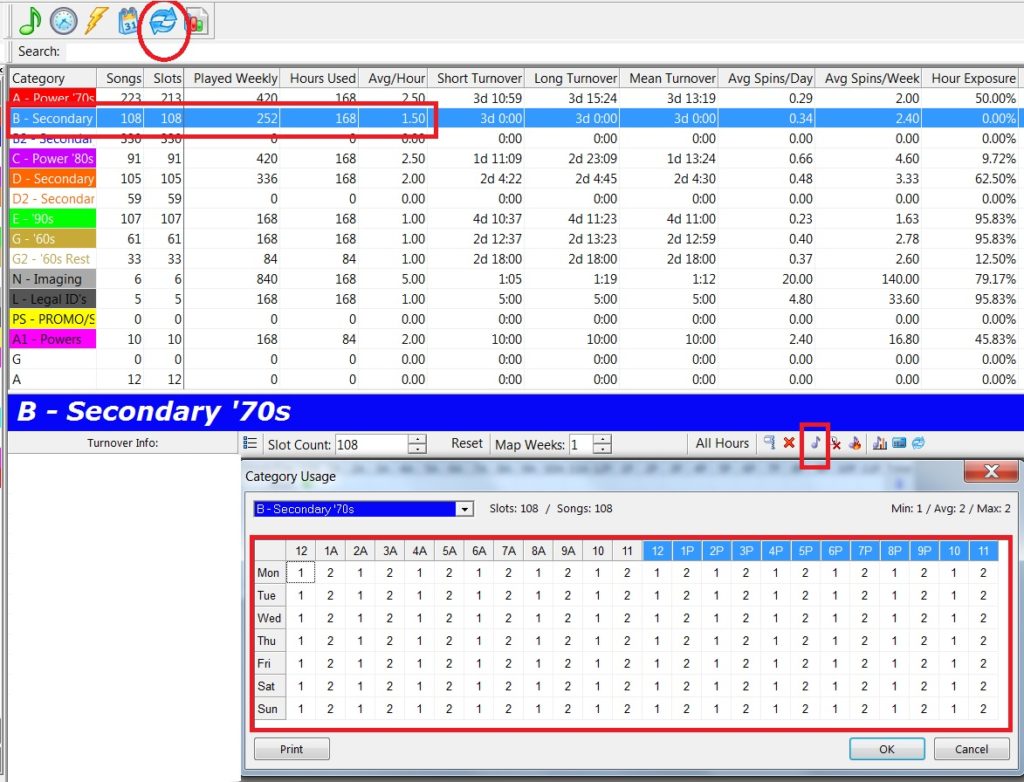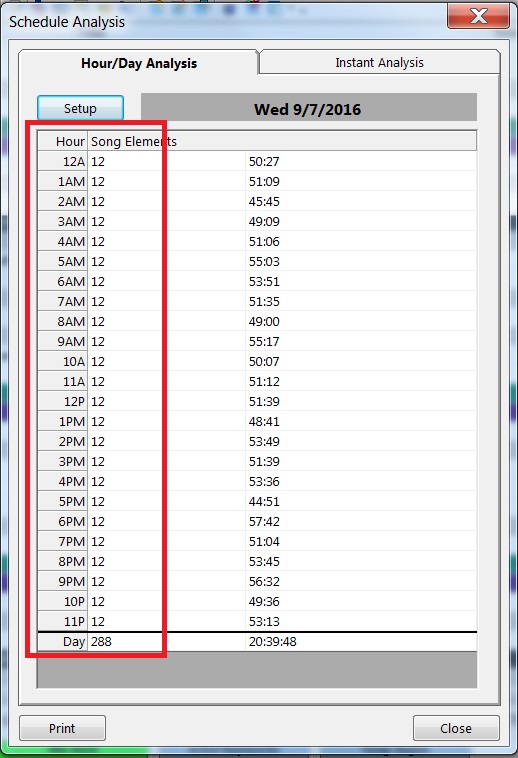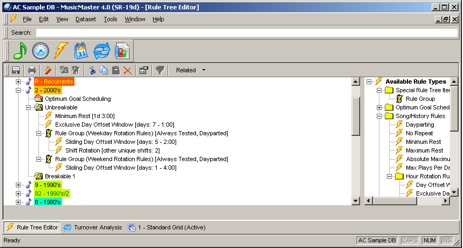MusicMaster Blog
Does Size Matter? posted on February 16th, 2023
By Dave Tyler
I get asked quite often about how large or small a music database should be for a successful station. It is an interesting and very broad question for sure. The easy answer is: I don’t know, what are you trying to accomplish? In this article, we will start from the science of creating a database playlist size and wind our way to a more philosophical look at having a small or large playlist.
A hot CHR might have a very small and tight database, while a streamer or local station might have a very broad playlist, and a Classical programmer may have 200,000+ pieces easily. There is no right or wrong size, only “What size most efficiently accomplishes your sound goals?”
Let’s get to the foundation of any station: Categories, Category Song Counts and Clock calls. These three things determine our “Turnover” or how long or soon it takes for the category to play each song once before the same songs play again on the schedule.
Let’s break it down further. When creating categories, you can think of them as folders where you store songs. Keep in mind that the categories you will use in your “Active” clocks/grids need to be thoughtfully considered because the amount of songs (Song Count) directly affects how quickly a song will play, rest and come back to play again, or turnover.
Clock calls are the final deciding factor on how Turnover will play out. As a simple example, if I have a HOT category with 6 songs in it (Song Count) and that category is used in each clock one time (Clock Calls) then my turnover will be every 6 hours. As another examples, if there were 24 songs in the category and the clock called for that category once per hour, it would take 24 hours to go through the entire category and in other words, each song would play would play once every 24 hours.
By the way, did you know you can see your Song Count without having to open the category? It is easy to set up. Go to Tools/Options/Library Editor Options and choose “Song Count” from Info Bar Options. (Pic below)
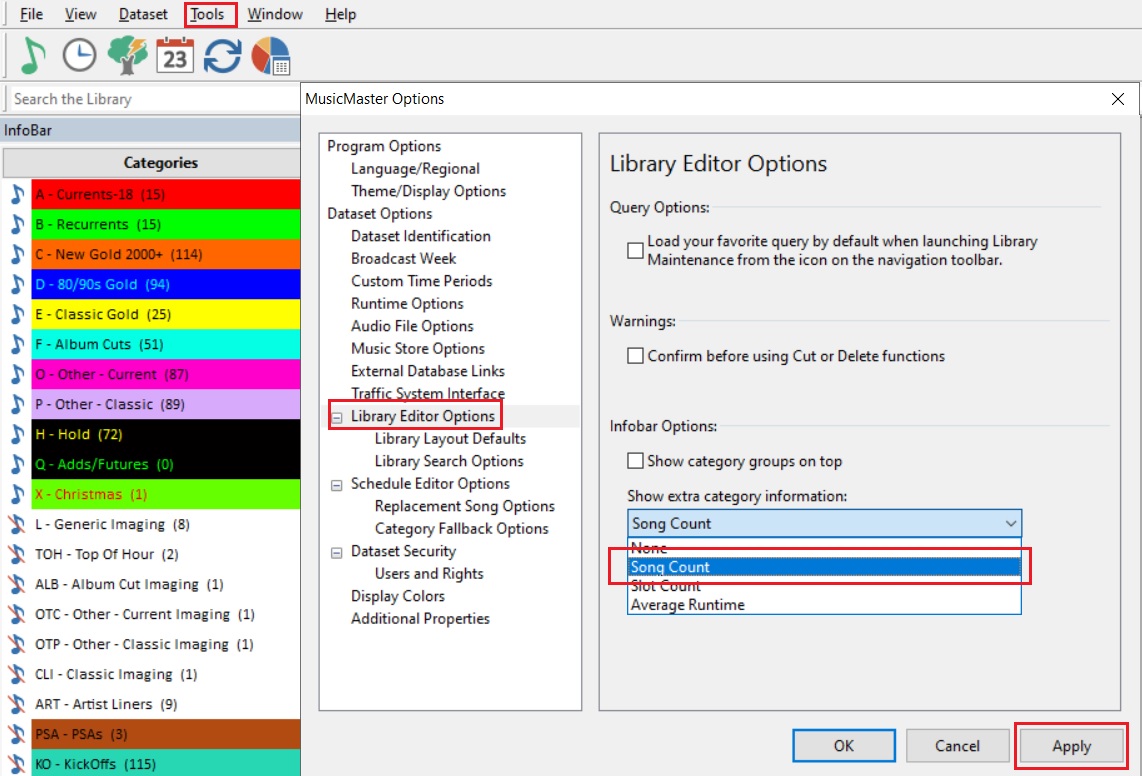
Going back to the start of Top 40, could you imagine having a playlist of just 40 songs? That is a tight rotation, but is it wrong? Again, there’s no right answer but if the goal was to play the newest songs that folks wanted to hear the most, then it is spot on. Of course, once a song falls off the list well…people still want to hear it sometimes. That’s the purpose of Recurrent and Gold categories. So, a small fast rotating “Currents” category(s) supported by larger but carefully curated, slower turning over Recurrent/Gold categories made a lot of sense. Give the people what they want, because like the old saying goes “Every song is a three minute opportunity to either keep a listener or have them switch to your competition.”
In MusicMaster, we have a couple of amazing tools that will show you what your turnover actually looks like. In the main toolbar, click on that icon with the two blue arrows in a circle…that is Turnover Analysis. When you click on this you get a full suite of information about how your categories plot, turnover, and move. In the example below, looking at the Recurrent category for this database, you can see there are 15 songs in the category playing an average of two per hour. The Short Turnover for this category is 6:56, the Long 14:24 and the Mean or Average is 7:29. Below that is a chart that gives an example of how one song in that category, not a specific song but how any song in that category would move. This is before rules come into play. Here you can see how the larger categories, even those with more Clock Calls, turnover slower because the song count is much higher.
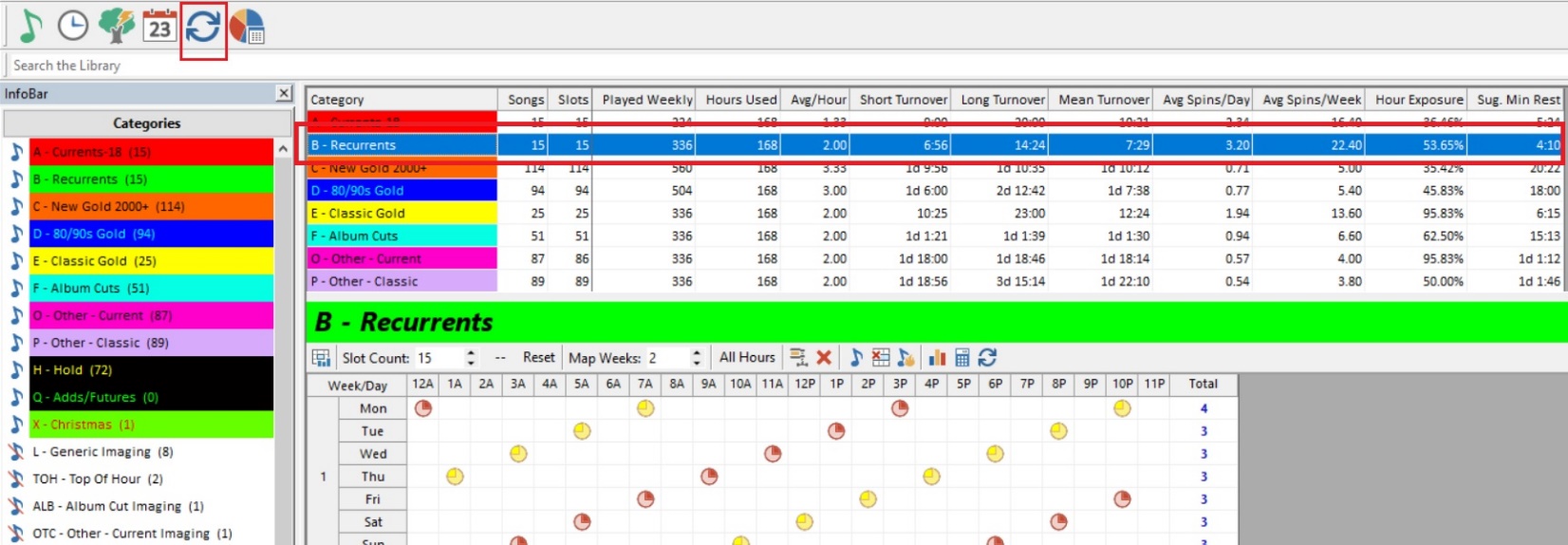
Now let’s look at that New Gold 2000+ category. It shows an average of 3.33 plays per hour. How can that be? Well if we click on the Format Clock Category Usage button (Clock Calls) we can see that they never actually have three calls for this category in any hour, it’s either two or four. But this averages out to 3.33. This too is a good place to gather up information when trying to determine where you want to be, what you want turnover to be, and how many songs vs how many clock calls will get you there. In short: to get a category to turnover faster, you can either have a smaller category or more clock calls. To get a category to turnover slower, either make it larger, or use it less often in the clock. It’s a balancing act to get you where you want to be!

Now let’s go to the philosophical side of things. How much music is too much music? Should I only schedule songs that are released by the labels and adhere to the Industry charts? What if I want to play deeper cuts off an album, would that make sense? Heck in the 70s with FM radio starting to get its feet under it, there was an entire format dedicated to that! AOR Album Oriented Rock! It’s one of the most well-known pieces of rock trivia that Led Zeppelin’s “Stairway To Heaven” was NEVER released as a single but it is arguably their most popular song by a long way and had us dashboard drumming years before “In The Air Tonight” or “Jack and Diane”! Why was AOR successful for it’s time? Perhaps we listened to music differently. When I would get an album I would go home, put headphones on, pull the liner notes or lyrics out, and listen to the whole album. Because a lot of people my age did that, maybe folks kinda knew the music already. We had heard the entire piece of work, not just the songs that would become singles. As a life long radio guy, I think I can listen to any album from any format that I’ve played over the years and find at least one song that I cannot believe never got radio play. I bet you can too!
The way we listen has changed since the iPod and then Spotify and Amazon etc. Like most radio people, my musical interests and likes are broad. I have playlists that include everything from Patti Page to Powerman 5000 (NOT on the same list!) and there is a LOT in between those two! I am a Singer/Songwriter ballad junkie and I have a cousin who is constantly sending me the greatest acoustic performances by people you’ve never heard of. Dylan, Carole King, John Prine level songwriting that most will never hear.
What are the main formats out there? Urban, CHR, Country, AC, Classical, Jazz and Rock. But then, think of all of the formats that have branched from these…the “Alt” formats of each mentioned above that were created to introduce us to folks outside the box. Heck, Americana may be the Godfather of these formats. It might be fair to say that a lot of these are run by Universities that have funding to support a lesser known more ambitious format, as opposed to having to serve the masses and hustle for advertising dollars, and maybe for that reason can take the risk.
I think music lovers/listeners are much more open to new sounds than ever before and are willing to give deeper, unknown artists/songs a chance. At the end of the day, we can ask our phones to play any song we want to hear on the planet when we tire of the unknown and want to hop back into our comfy place. Some stations with tight playlists have feature programming later at night or on the weekends that might show off some of these incredible fringe performances and the people who are interested can tune in at this specific time.
I work frequently with a Programmer who believes 300 actively rotating songs is the max for a Country station and 200 would even be better and 150 better still. On the other side of things, I have a client with a massive library that literally has every song from the artists they play. All the hits and all of the album cuts, and they rotate equally with the goal being that every song will play before the list starts over. Which one of these programmers is correct? To bring it full circle, they both are if they are accomplishing their goals. One may be feeding listeners nothing but the hits while the other aspires to broaden their listeners by presenting tunes they likely have not heard before or going for variety. Goals being met = success, whatever those individual goals may be.
A Streamer might focus on a feel or vibe while a terrestrial station picks a format and does just that and keeps it simple but good. A “Hobbyist” on a stream has the incredible freedom to play anything they want, while the PD of several stations has a bottom line because this is a business. I run a pretty tight playlist but I am also a big fan of my “Variety” or “Oh Wow” category of songs that go pretty deep but are all well known songs that just kind of went away. I use it sparingly but love the idea of a listener going “Dang I forgot about that song!”
At the end of the day, the playlist size that is right for you is up to you and will likely change as you change. From huge playlists that take months to turnover to tight lists that keep the hits in the ears of your fans…we can help you with both. Just let your Music Scheduling Consultant know what you are looking to do and we’ll work with you to make it happen. That great radio in your head can come out of the speakers. Let’s get to work!
Coding Analysis posted on November 4th, 2019
By Paul Ziino
We’re all familiar with Turnover Analysis, which you can access by clicking the blue circling arrow icon in the Toolbar or the menu Dataset/Analysis/Turnover Analysis. It allows us to see predicted turnovers of the songs in our categories. There’s a cool little button in this part of the software that allows us to see the predicted turnovers of our coding called “View Coding Analysis.”
Click that icon and select the field you’d like analyzed. Let’s start with Gender.
This tells us we have 45 F-Female coded songs in the library and that we should expect to hear approximately 79 plays of Female coded songs per day, 558 per week, and generally expect about 15 minutes between plays. Its density in the library is 20%. As we look at the screen we see that the density between Male and Female, when totaled, is greater than 100%. Why? Because some songs in the library may have both codes listed representing a male/female duet.
Next, I ran analysis on my Sound field.
This tells us we don’t have many ballads, Dance/Disco, New Wave, or Urban songs in the library, and as such we shouldn’t be hearing very many of those songs. Again, the Density totals to be more than 100% because songs have more than one code assigned.
You can even analyze keyword fields. By default they will be sorted alphabetically, but you can click on any column header to sort by it. In the following, I’ve sorted Artist Keywords by the Count column.
Here we see in this database that John Mellencamp is our most-used artist keyword and that we can realistically expect his songs to appear every hour and a half. That’s followed closely by Phil Collins and Huey Lewis. Why does Van Halen have seven songs but we expect to hear that artist every 1:33 whereas we have eight songs by Huey Lewis and can expect to hear that artist every 1:46? It’s because the categories with Van Halen rotate faster than those containing Huey Lewis.
Using the Coding Turnovers can really help when it comes to building rules. For example, we can’t expect MusicMaster to be able to sustain a rule that says we have to be 50% Rock when only 30% of our library contains that code. We can’t expect a five hour artist keyword separation rule to work when we have artists that should be playing every 90 minutes.
When you look at all the information MusicMaster can provide, it will really help you set up your rules and rotations. For more help, contact your MusicMaster Scheduling Consultant.
What is “Hour Exposure?” posted on July 1st, 2019
By Paul Ziino
Head to Dataset/Analysis/Turnover Analysis. Once it loads in the upper half of the screen you’ll see all your categories and a number of columns. You can add and subtract columns by right-clicking in that upper half and checking additional columns. The column we’re discussing today is “Hour Exposure.”
Hour Exposure is the percent of hours a song from that category will play in before repeating in an hour. The highest number you will see is 95.83% which indicates a song is predicted to play in all hours before repeating in one of them. The lower the percent, the fewer the hours the song will hit before repeating in an hour.
If you have a category that doesn’t play 24/7 its Hour Exposure percent will drop. If category X only plays from 6pm-6am, that eliminates 50% of the hours, so the highest score you’ll see is 45.83%. If the category is only played in 6 hours of the 24 hour broadcast day, the highest hour exposure possible will be 20.83%.
When we are using Turnover Analysis to look at predicted rotations, we’re looking to maximize the Hour Exposure, without causing stacking in the predicted play rotation. Looking at Category A we have a 45.83% hour exposure. We do see some stacking in the predicted play history.
If we adjust the slot count up and down we can see how this will change not only the Hour Exposure, but also the predicted rotation.
In this example, not only is the Hour Exposure lower, but the predicted rotation is pretty rotten, too.
Following is an example where we get that stairstep but still have a low Hour Exposure. That’s because the rotation is predicted to hit the same six hours over and over.
Add three more songs to the category and your Hour Exposure jumps to the perfect 95.83%.
As always, if you have any questions, please follow up with your MusicMaster Scheduling Consultant.
How Many Songs Am I Really Playing? posted on September 18th, 2017
Dave Tyler
As one of the Music Scheduling Consultants here at MusicMaster I get calls from Programmers from all across North America on a daily basis. Every day is different and so are the questions. I enjoy the challenge of finding solutions for our clients to unique questions.
Recently on of these terrific programmers called and said that because of great numbers in a recent book they are sold out! Great news! He also said because of this their stopsets are full and sometimes even over what they are set for and he knows as a result they are playing less music. His boss wanted to know how many songs are being played each hour given this “Sold Out” situation. With Turnover Analysis we can easily see the average song count and the actual calls for the category per hour. In the screen shot below you will see that I click on the Turnover Analysis icon (2 blue arrows) and in my example we are looking at the B category (Secondary 70s) in the top part of the graph we can see how many songs are in the category how many times the category is scheduled weekly, how many hours the category is used in, the average plays per hour and a whole lot more information that pertains to the category. I can also see exactly how many times per hour, specific to the hour, that category is being used by clicking on the small musical note in the bottom half of the screen for “Format Clock Category Usage” then using the dropdown I select my B category and there is a grid with the exact clock calls.
This was all good information but this particular Music Director said his PD actually needed to know not how many songs were scheduled from each category but how many songs were actually playing on the air each hour. Like most of us they overschedule the end of their hours in the event that they run short and songs get bumped and being sold out is only amplifying this in their case. Finding this information is different but totally doable in MusicMaster Pro. This client reconciles their music against their aired log from their automation system on a daily basis so MusicMaster knows what actually played. To see this very specific information simply open any day you wish to find this information for then click on the Schedule Analysis button.
Now click the “SetUp” button and enter the settings below. We want to test the current day and test just the Song Elements (which are Music from the dropdown) the against setting would be “[None]” and the Display is count.
Now click OK and you will see exactly how many actual songs played during that hour.
This very specific data about actual “Aired” plays is very important especially if you are positioning with “We Play The Most Music” or “12 Songs Every Hour GUARANTEED”. This particular feature also requires a reconciliation.def file. If you do not have one just contact your MusicMaster rep and they will create one for you based on your automation system.
Musicmaster Pro is developed by radio people for radio people and this is just one of many functions to help you better know and program your station.
Time-Saving Music Log Reports posted on June 5th, 2017
By Drew Bennett
Today, it’s tough to juggle everything you need to juggle at the station. Even the music department can be something you explore to find ways of saving time. One of those ways is to build reports and run them against a log you scheduled to make sure everything looks good before sending it on to automation. In today’s tip, I’m going to talk about the reports you should run before sending any music log to air.
The Consultant Asks… Why MusicMaster? posted on September 15th, 2014
By Marianne Burkett
I have many clients who also happen to be programming consultants… and the times, they are a changing. Now that MusicMaster is thoroughly saturating the Music Scheduling world – many consultants want to know what the advantages are and what are the differences between MusicMaster and the other Music schedulers on the market. (more…)
Additions to Turnover Analysis posted on September 17th, 2012
By Aaron Taylor
We’ve enhanced the Turnover Analysis screen for version 5. There are two new options you may want to check out, “All Hours” and “Predicted Rotations for Field Values”. Go to Dataset-Analysis-Turnover Analysis, or click on the circling blue arrows on your toolbar. (more…)
Using Rule Groups to “Ignore” Weekday vs Weekend Plays posted on May 1st, 2011
By Marianne Burkett
This is quite simple to set up, so if you follow this step by step you’ll be done in no time!
Open your Rule Tree and go to the very first folder in Available Rule Types on the right hand side of the rule tree, called “Special Rule Tree Items”. Inside that folder you’ll see Rule Groups.
First drag two rule groups into either the Breakable or Unbreakable folder of the first category you’d like to work on. Identify one Rule Group as your weekday rule group and the second as your weekend rule group. Once you’ve created a Time restriction for each rule group…be sure to select from the drag down menu immediately below your Time Restriction window “Ignore plays outside this time period”.
See illustrations below:
Once you have these first two Rule Groups set up, don’t populate them yet! Copy and paste the empty rule groups into the other categories you’d like the “Ignore weekday or weekend rotation rules” to adhere to. Once you’ve done that, populate your rule groups with rotation rules that make sense for each category. In the close-up below you’ll see a Minimum Rest rule and Exclusive Day Offset rule that are “outside” the rule group and will be adhered to 24/7. Inside the rule groups you’ll see some “dayparted” or “time restricted” Rotation Rules.
Also, in the example below, the Sliding Day Offset rules are different since we’re dealing with a larger window for the weekday rule group and a small window for the weekend rule group.
Remember, each category rotates differently, so be sure to utilize the power of the MusicMaster Turnover analysis icon, which on the illustration above is the blue arrow icon next to the calendar icon. The turnover analysis will give you a good idea about what kind of rules you need, such as day offsets or play offsets. The day offsets test from day-to-day, and are often used with small categories where a song would play every day or several times a day. In the next illustration you’ll see The Recurrent category will play almost everyday:
Play Offset Windows are used on categories that turn over at a much slower pace, like the sample below:
For more information about how to set up Rule Groups and the correct rules for your library, contact your Music Scheduling Consultant!
Ideal Turnovers posted on February 1st, 2011
By Drew Bennett
Let’s say you have the rare opportunity to totally overhaul your database. You’ve been thinking about new clocks and rotations and you want to get started on bringing better rotations to your station.
When it comes to scheduling music, clocks are ‘where the magic happens.’ (more…)
MusicMaster Turnover Calculator posted on May 28th, 2010
Did you know there is a calculator hidden within MusicMaster Windows? This cool utility can be found in the Turnover Analysis section of the software (to get there, click on the two circling blue arrows icon on the toolbar, or by selecting DATASET-ANALYSIS-ANALYSIS). On the lower level of the split analysis screen, you’ll spot a row of icons and the calculator icon can be found there. This is the Turnover Calculator, and it allows you to play with the number of songs in the category (Slot Count), the number of times you call for it (Avg. Per Hour) and the turnover time (Avg.).
By using the calculate buttons, you can see graphically what the turnover would like with various setting To use this, change one of the three fields shown, and then click on the calculate button you want to view. For instance, if you were setting up a new category and you knew that you wanted a turnover for the category of 29 hours (1d 5:00) and you wanted to play four songs per hour, you would fill in those two pieces of information. You would then click on the Calculate button to the right of Slot Count. MusicMaster would then determine you need 116 songs in the category.
If you are contemplating making clock/category changes, I think this is an invaluable tool to help you make decisions on “what you should do” to achieve your rotation goals.
Keep in mind, the turnover calculator is showing you graphs for a category with a 1 search depth and no rules. The use of search depth and coding and rotation rules will effect the overall turnover pattern in real-time scheduling.
If you have any questions in regard to the Turnover Calculator or any other feature of MusicMaster, contact your Music Scheduling Consultant.










